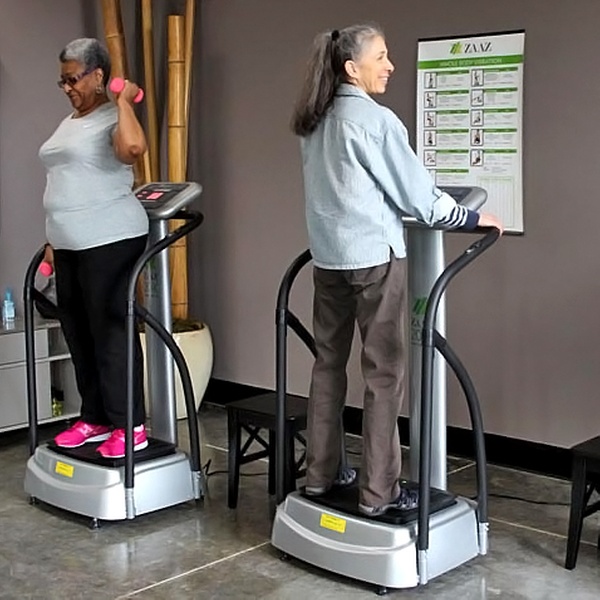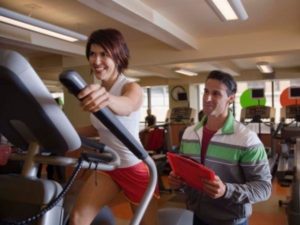
Diagnosed with Cancer? Your two greatest challenges are understanding cancer and understanding possible side effects from chemo and radiation. Knowledge is Power!
Learn about conventional, complementary, and integrative therapies.
Dealing with treatment side effects? Learn about evidence-based therapies to alleviate your symptoms.
Click the orange button to the right to learn more.
- You are here:
- Home »
- Blog »
- side effects ID and prevention »
- Whole-body Vibration- Bone, Muscle, Lymphs User Experience
Whole-body Vibration- Bone, Muscle, Lymphs User Experience

“Growing evidence supports the use of this treatment tool, in combination with exercise, for improving flexibility, bone density, balance, strength, and pulmonary rehabilitation.”
Whole-body vibration is easy exercise. “Easy exercise” may sound like an oxymoron (think “jumbo shrimp”) but according to the research linked and excerpted below, standing on a vibrating plate/platform:
- strengthens my bones
- helps my balance/leg, hip strength
- rehabs my heart
I am a long-term cancer survivor. The good news is that I have been living with an incurable blood cancer called multiple myeloma since my diagnosis in early 1994. The bad news is that I also live with a long list of long-term and late stage side effects. No, aggressive chemotherapy/radiation is not the reason why I’m still alive…
My life is more about coping with the side effects of conventional therapies now as it is about cancer…
I believe that standing on my Maxuvibe (brand no longer available in the U.S.) for about 12 minutes a day helps me stay ambulatory. I do this right before bed each night. My legs are pretty useless once I do this.
For the record, I also exercise at my local LifeTime Fitness. I can’t do much but I do light weights on a number of different machines. And I do some cardio on an elliptical every other day.
I used to think that exercise meant grueling work-outs, lots of sweating and exhaustion. I guess my point is that modest but frequent exercise is important.
To Learn More about Exercise Enhancing Overall Survival- click now
Do you have physical limitations that prevent daily exercise? Scroll down the page, post a question or comment and I will reply to you ASAP.
Hang in there,
David Emerson
- Cancer Survivor
- Cancer Coach
- Director PeopleBeatingCancer
Recommended Reading:
PeopleBeatingCancer Side Effects Program
Whole Body Vibration: Potential Benefits in the Management of Pain and Physical Function
Growing evidence supports the use of this treatment tool, in combination with exercise, for improving flexibility, bone density, balance, strength, and pulmonary rehabilitation.
Conclusion
Overall, whole body vibration appears to be a promising, complementary, easy-to-integrate tool for the management of certain types of chronic pain, physical functioning and mobility, bone strength, and balance. Benefits of WBV therapy, when combined with exercise, appear to be even more promising.
Healthcare professionals are urged to take a serious investigation into the promising effects of WBV in regard to sedentary, rehabilitating, chronic pain, and older adult populations as the aforementioned effects of WBV show support of offering a low-impact, low-stress method to help recondition individuals. These factors, along with increased functional mobility and decreased pain, may be the main proponents to high adherence to WBV treatment protocols. The evidence WBV has demonstrated on individual health measures warrants further investigation into its effectiveness as a method for relieving pain and improving overall strength and physical function…”
Effects of whole-body vibration on proxies of muscle strength in old adults: a systematic review and meta-analysis on the role of physical capacity level
“Background: Dynapenia (age-associated loss of muscle strength not caused by neurologic or muscular diseases) and functional limitations (e.g. climbing stairs, chair rising) are important problems in elderly persons.
Whole body vibration, used as an adjunct to classical resistance training or even as a stand-alone alternative, might help to reduce these problems. Its value might be highest in elderly persons with very low function, where whole body vibration can be used as a skilling up training until more conventional exercise types are possible. This systematic review and meta-analysis summarized the current evidence for whole-body vibration interventions on isometric maximum voluntary contraction, dynamic strength, power, rate of force development and functional strength in elderly categorised in different subgroups based on function levels…
Conclusions: Whole-body vibration shows beneficial effects, mainly in the No-Go group elderly compared to non-training control and conventional strength training groups. The results suggest that WBV can be used as a skilling-up exercise in participants not able to perform standard exercises. Further studies with the various types of WBV in various sub-populations of elderly persons are needed to determine the most effective vibration modes…”
Exercise for preventing falls in older people living in the community
“Authors’ conclusions: Exercise programmes reduce the rate of falls and the number of people experiencing falls in older people living in the community (high-certainty evidence). The effects of such exercise programmes are uncertain for other non-falls outcomes. Where reported, adverse events were predominantly non-serious.Exercise programmes that reduce falls primarily involve balance and functional exercises, while programmes that probably reduce falls include multiple exercise categories (typically balance and functional exercises plus resistance exercises). Tai Chi may also prevent falls but we are uncertain of the effect of resistance exercise (without balance and functional exercises), dance, or walking on the rate of falls…”
Simple Exercise Interventions for Osteoporosis and Sarcopenia in Older Men
“Resistance training, whole body vibration, and use of spinal orthoses resulted in significant improvements in musculoskeletal performance in in older men at risk for osteoporosis and sarcopenia, according to findings published in Bone Reports.
Investigators enrolled 57 men aged 65 through 90 years at risk of developing osteoporosis into a prospective, randomized, controlled, single center trial; 47 men completed the study. The men were divided into 4 groups: resistance training (n=11), whole body vibration (n=13), Qi Gong exercises (n=10), and spinal orthotics (n=13). Each group was studied for 6 months to determine efficacy in deterring age-related declines in musculoskeletal performance.
Primary endpoints included change in isometric one repetition maximum force trunk strength for extension (TSE) and trunk strength for flexion (TSF) compared with baseline measurements. Secondary endpoints included geriatric functional capacity assessments such as Handgrip Strength, the Chair-Rise Test (CRT), the Usual Gait Speed (UGS), and the Timed-Up-and-Go (TUG) Test. The investigators collected measurements at three separate points: at baseline, at 3-months for an interim analysis, and 6 months at the study’s conclusion.”


